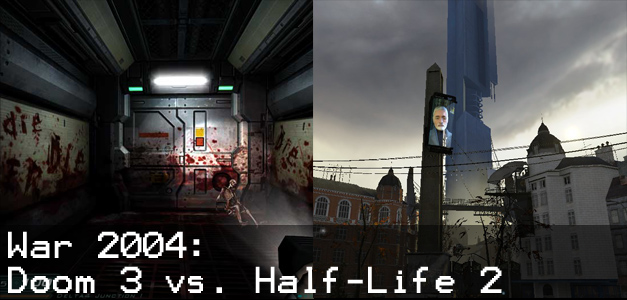
Looking back, 2004 was a milestone not only for a genre of video games, but for the industry as a whole. In August of that year was the release date for Doom 3; which at the time was the latest game for a series that many people hold true as their favorite of all time. Then a few months later in November of that same year was the release date for Half-Life 2; the highly anticipated game that was six years in the making. Both of these series are highly regarded from the gaming community, but it also created a bit of a rift.
As demonstrated at conventions like E3, both of these games were visually impressive. They were taking advantage of the latest and greatest of consumer PC hardware had to offer. High levels of detail such as lighting and shadowing effects, texture rendering, enemy AI, and physics were some of the items that were noted with these games and both were being designed on new game engines the developers built themselves. For example, Id Software had Doom 3 running on their latest engine: id Tech 4, while Valve had Half-Life 2 running on their own engine called Source.
During this time in the early half of the aughts, PC hardware requirements were still a big thing to consider for top-of-the-line games as each generation of hardware were much larger jumps in performance as they are now, so you can have a PC get out of spec requirements relatively quickly. Also, the kind of hardware used was sort of something to consider too, as to squeeze as much performance as you can get out of a game.
For Doom 3, they were using OpenGL (an API for rendering graphics) and Valve was focusing on using Direct3D for Half-life 2. From a marketing standpoint for video cards, OpenGL was associated with Nvidia while Direct3D was with ATI. This meant the end consumer -- but more importantly, the core PC gamer -- would focus on getting an Nvidia GeForce series of video card if they were building their PC for Doom 3 while fans of Half-Life 2 were going to get an ATI Radeon card.
Speaking of which, these two games were the reason why so many gamers built their new computers for. They were following the progression of each game and hearing what hardware to buy for them. With these new game engines, you can see a huge difference in graphics between PC games before these games were released. One of the biggest jumps was probably character models.
While there were some who were picking sides, there were still a lot of people on the fence trying to figure out which game to get. Forums would have “Doom 3 vs HL2” type threads that asked what game looks and plays the best. And as expected, arguments and flame wars followed said questions. But as time passed and we got closer to the release date for Doom 3, retail stores were ramping up hype for it and soon everyone would finally get to actually play the game they read so much about.

Doom 3 would not be a continuation of the story, picking up after the events of Doom 2. It would instead be a reboot as if the events of the first two never happened. Even though they did this, longtime fans of Doom would feel right at home due to id sticking to all of the familiars.
It’s interesting to hear how Doom 3 came to be. Internal talks regarding id’s next game had mixed feelings. Doom was put aside throughout the latter half of the 1990s when the Quake franchise was brought onto center stage. And after the third Quake game, Quake III Arena, was released in 1999, meetings at id were about where the company should focus on next. John Carmack was against going forward with an alternative project that was being discussed, and others did not like the online gameplay activity Quake III had. So focus was ultimately pointed towards a single-player game and most agreed it was time to go forward with a Doom remake with new technology.
In regards to new technology, this meant there would be a new gaming engine from id - id Tech 4. So before creating Doom 3, development for the engine began starting in the year 2000 and required high hardware requirements. It would all be needed as they were focusing heavily on lighting and shadowing. Different from previous id Tech engines that created a sort of pseudo dynamic lighting effects, id Tech 4 would incorporate actual dynamic lighting called per-pixel lighting. This basically meant any light source in the game would cast shadows on objects near it and different types of light sources would cast different kinds of shadows.
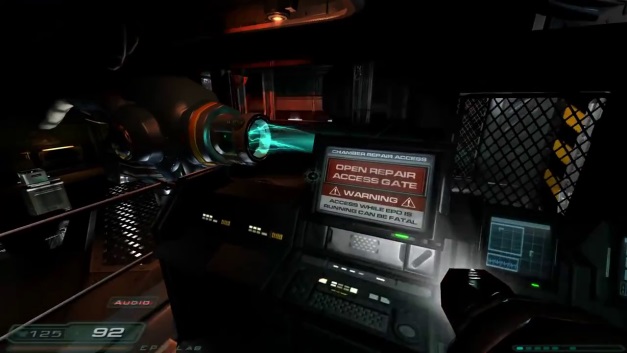
2002 and 2003 would include a few speed bumps during development. In 2002, a leaked version of the E3 2002 demo appeared online. It was found the source of the leak may have accidently come from ATI Technologies, though it was never confirmed. The game was in a sort of pre-alpha state, so a lot of what was on that executable was broken, unfinished, and unpolished. Doom 3 was also originally scheduled to be released during holiday 2003, but development took longer than originally anticipated so its release date was pushed to 2004.
August 2004 would eventually become the release date and anticipation was soon in the air as stores like Best Buy and Circuit City had midnight sales to ring in the long-awaited game.
Like in the original game, the premise is the same: a research facility on Mars opens a portal to Hell. The player takes the role of a marine and needs to fight the many demons that now haunt the base. But instead of a basic synopsis found in the instruction manual, Doom 3 has a more detailed story that is told throughout the game. It will be told through a number of ways like cutscenes, audio logs, emails, and scripted in-game moments. Written by author Matthew Costello, the story delves deep into the UAC, the company that operates the research facility, and provides details of the company’s culture that helps convey how they got to the horrendous event of unleashing Hell on Mars.
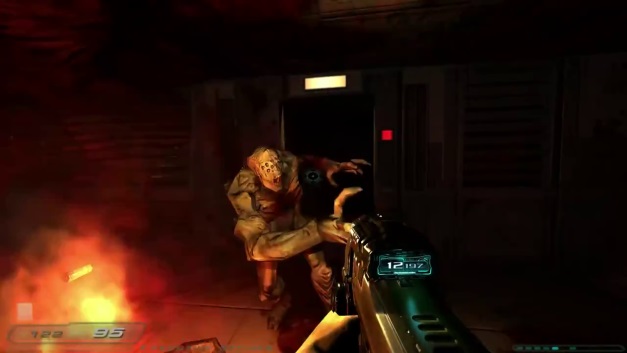
From a graphical standpoint, everyone was impressed. Basically every review for the game at the time praised how phenomenal the graphics were. One of many impressive visuals was the interface for all of the computer terminals and the PDA. The text was always sharp, crisp looking and never fuzzed; even when the display is a distance away like from across a room. Another example -- as noted earlier -- was the lighting and shadowing of the environments. Light sources are important in this game; otherwise you are walking blindly in darkness. When there is a light source, it will cast shadows from objects that are within the light’s range, so the environments always have a stark contrast of light and dark.
Speaking of environment lighting, Doom 3 has an incredibly spooky atmosphere. The Mars base looks very used and worn-down as large power cables are haphazardly placed on the ground connecting panels across a hallway, steam pipes burst near you causing the environment to fog up a bit, and hauntings of whispering voices and paranormal events will create a tremendous amount of tension as if you’re being watched and are never alone. Enemies can jump out of the shadows at any moment and attack you. Sometimes a section of the facility will lose power and the room will go dark leaving you with only your flashlight as the only source of light to see with. And regarding the flashlight, this relates to the only negative consistent opinion about Doom 3 – the gameplay.

Taking the traditional way the game feels very old school. Some note the gameplay is very repetitive because you shoot enemies, move to a new location, and shoot more enemies. This may have been the de facto standard for an FPS game during the ‘90s, but some wanted more than just showering your enemies with bullets. There are, however, a few breaks from all the shooting as you solve puzzles by using large industrial equipment to help remove some roadblocks. Although critics noted the gameplay was dull, it doesn’t really mean that’s a bad thing. It can be seen as inviting for gamers that played the originals 10+ years earlier but dropped out of playing games for a while; kind of like how people praised Capcom when Street Fighter IV went back to traditions with Street Fighter II gameplay. Older players felt right at home and didn’t need to learn new systems that the SF III games brought.
Another problem with the gameplay was having to switch between using either the flashlight or a weapon. This was probably the biggest gripe regarding to the gameplay. Some users in the gaming community quickly created a patch following the release that allowed the player to use both at the same time. This patch was famously called "duct tape mod" as the flashlight was supposedly taped onto the gun or vest.
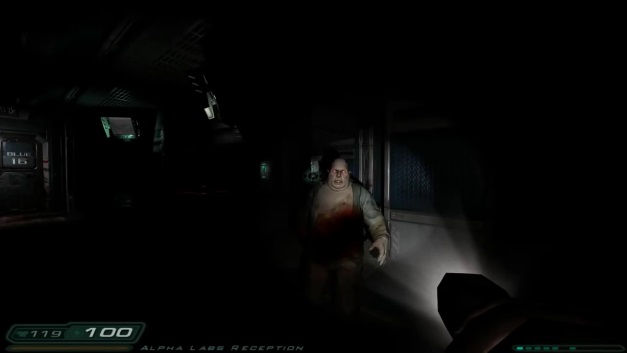
Keeping with the tradition, all of the og weapons are here, including favorites like: the shotgun, machinegun, chaingun, and the BFG 9000. In addition, some of the demons from the original return as well. Some of them include the Imp, Lost Soul, and Cacodemon. But to keep things new and fresh, there are new enemies as well. All of them look fantastic and all are terrifying, especially when they sprint towards you giving a hellish howl.
Doom 3 has high peaks and low valleys. The peaks come from an impressive gaming engine that outputs incredible looking visuals that show off how far gaming has come, just like the original Doom did back in 1993. Likewise, the low valleys are related to the outdated gameplay that sticks to what the original brought to the gaming world back in 1993. Even though critics at the time noted its shortcomings, all still regarded Doom 3 as a game worth playing.

With D3 being out on store shelves, everyone started looking ahead towards the release of Half-Life 2. At this point, people could then begin to make a more educated decision on what game to purchase after the reviews came out for Doom 3 and friends having played the game.

Of the two games, Half-Life 2 had the more interesting development story due to its length of development time and drama that occurred within it. Shortly after the original game was released in 1998 was when development for Half-Life 2 begun. Gabe Newell told his team “You don't have to worry about how long it's going to take. You don't have to worry about how much money you're going to spend. The only thing you have to worry about is making it the best game of all time.”
With ambitious ideas in place, they originally decided to go with id Software’s latest game engine – id Tech 3 – that powered games like Quake III Arena. However, id’s engine wasn’t going to cut it this time as when they originally used the id Tech 2 engine for building the ground work for the original Half-Life. To reach their goals, they would need to create an engine themselves that meets all of the requirements for their new game. Thus started the three year development cycle needed to build their own game engine called Source.
Things seemed to be going fine for the team. They showed Half-Life 2 for the first time at E3 2003 with Gabe noting the release date for later that year. ATI would hold an event on Alcatraz Island on September 30, 2003 for the release date of the game. But unfortunately Valve would not be able to meet this deadline. Gabe would have to go on stage at this large event with the press as part of the audience to say that the game has been delayed. With that sour note, Gabe returned to Washington, defeated knowing he let down his business partner, ATI, the reporters, and ultimately, their fans. However, things only got worse.

Shortly after the ATI event, he noticed odd things were happening to his computer. Even with a reformat of the operating system and a virus scan, the problems continued. He would find out that his computer was infected and so were a number of computers at Valve. Someone was stealing their emails, game engine code, and game assets. A hacker placed a hidden partition on these computers that allowed him to spy on the company. He was leaking everything he stole on the web, including parts of the game and character models.
With the FBI not helping as much as Valve wanted, they turned to the gaming community to assist in finding the hacker. With an active number of people on the case, they were able to find the hacker was from Germany. And with the noose slowly tightening around his neck, he confesses to Gabe and pleads for forgiveness. Now communicating with the hacker directly, Gabe tricks him by earning his trust and says he even has a job for him regarding network security. However, this was a setup with the FBI assisting. The plan was to arrest him as soon as he got off the plane when he landed in Seattle. But the plan was foiled when the German government caught wind of the act and arrested him while still on German soil. With the leak fixed, the team was able to breathe a sigh of relief and continue their work uninterrupted.
Months later in November 2004 is when the game would be finally be finished and released to fill store shelves. Six years in the making, Half-Life 2 was not only shipped to stores, but was on Valve’s new distribution platform called Steam. With this, they can sell games directly to their customers, making for excellent profit and allowing game patches to be sent immediately so everyone can be up-to-date with the latest fixes quickly and easily. Patience from fans would soon payoff as this game did not disappoint.
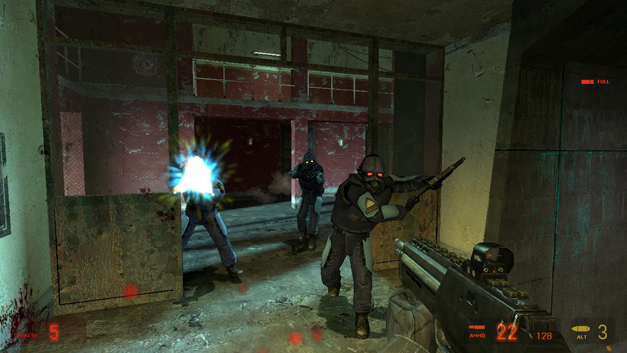
The game begins things in a very confused manner as the G-Man wakes you after the events of the first game. In what seems like a lost dimension, you are transported and placed in a train car that is arriving at a station. When you get out, you are in a metropolitan referred to as City 17. However, things don’t seem right. Everyone is warring the same drab clothing and seem to be suppressed by a government that uses alien-like technology. You eventually find out many years have passed since you’ve been away and the planet is now in shambles and humans are no longer in charge. Wielding your trusty crowbar, it’s up to you to set things right!
Continuing the roles as Dr. Gordon Freeman, a theoretical physicist who was involved in an experiment gone horribly wrong at the Black Mesa Research Facility in New Mexico, he is needed again but this time to help humanity free themselves from their oppressive rulers. However, the issue has now expanded beyond Black Mesa and now covers all of planet Earth. The enemy you’ll be facing is a head-to-toe covered/gas mask wearing army called the Combine. They keep humans in check and make sure no outbursts occur under their watchful eyes.
The graphics in this game are superb. Environments are given high levels of detail and most objects in the game are interactive; either by function or by just picking something up with your hands. On streets and through buildings, you wonder around City 17 and its surrounding landscape as you try to help the resistance group. Parts of the game will even have you travel long distances with different types of vehicles that are fun to control and change things up a bit from the routine of always shooting Combine soldiers.
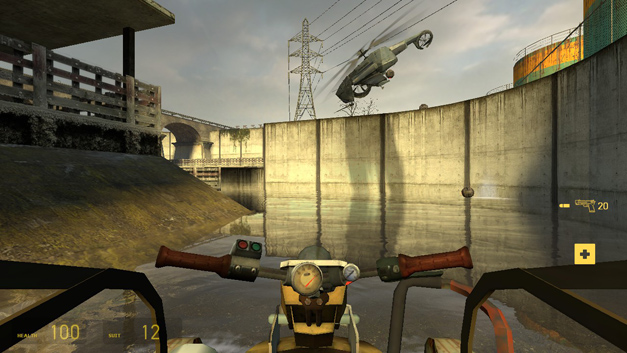
Your journey will have you meet both new and familiar characters that help you along the way; supplying you with cool weapons like the gravity gun. Oh yeah, I forgot to mention that the Source engine incorporates the Havok Physics engine that gives every object in the game its own mass and weight. Having the gravity gun is probably the greatest weapon in the game as it allows you to pick up heavy objects scattered around the place and hurl them at your foes. In fact, a section in the game was created as a sort of sandbox type environment for you to go nuts with this gun. It’s both scary and fun at the same time!
In addition to the environments, the more impressive part of the game would be the character facial expressions. At the time, most PC game characters looked like manikins that had a flapping jaw when they spoke. In Half-Life 2, their faces expressed many types of emotions, their eyes moves around, and their mouths moved the way you’d expect a human’s mouth move when speaking. To help with this task, Valve used Dr. Paul Ekman’s catalogue of facial expressions with animating the faces of all the game characters. Sure enough, their research paid off well as they look and move in lifelike ways, even today nearly 10 years later.

Similar to the original game, the enemies you face will be of two types: a human type that has excellent AI and can wield a gun, and the other are alien creatures that have limited intelligence but can be erratic and tough to kill. One, for example, is a Starship Troopers looking alien called an Antlion that is fast and aggressive. The fun thing about this creature is that you will be able to control them for a part of the game. This is incredibly cool because you can command them to assist you with attacking a group of Combine soldiers that may be difficult to get past with just yourself.
With a strong story that keeps things moving along, you’ll be propelled towards the end of the game in no time. With a FPS, you’d expect the story to be weak. And hey, maybe the story of Half-Life 2 is one. But the ways Valve included you, the player, into the shoes of Gordon Freeman and see the world from his perspective, as each character looks at you, and includes you into their conversations, one can’t help but to be pulled into the story and the world that Half-Life 2 brings to the table. Overall, the game is a full package that not only delivers on its gameplay but also impressed many with their use of physics, storytelling, and environments.

Comparing both games from a visual standpoint, it was Doom 3 that was more impressive with its environments, thanks in part to the lighting and shadowing techniques. When Half-Life 2 launched, it was lacking with shadowing effects. They would, however, catch up a few months later in 2005 when they showed off Half-Life 2: Lost Coast. This was mainly a demo level showing off the new addition to the Source engine that does a much better job at handling lighting and shadowing. Called high-dynamic-range rendering (HDR), this technology allowed a number of lighting effects to be added to a game built on the Source engine; giving environments a more realistic appearance.
But when it came to character models, it was Half-Life 2 that took the medal. Doom 3 models looked like action figures compared to the high details shown off in HL2 that made characters look more lifelike than any other game made to date. With Doom 3, eye balls kind of just looked around; hands were sausage-y and stiff; and the jaws of characters would look and move the same way for any character model that was talking. With HL2, and as noted earlier, the facial expressions mimicked many human emotions very closely and hands could dynamically be opened, clenched, and have gestures such as using the index finger to point towards a direction or object.
With gameplay, HL2 seems to be the winner here, but it could be debated whether it was great gameplay. With HL2, the AI for enemies performed better than the enemies found in D3. Predictable patterns and tight environments turned Doom 3 into a shooting gallery. With HL2, half of the enemies were human like and acted like a trained, coordinated group, while the monsters in D3 had no coordination with each other, giving the feeling like there was no dynamics when battling with foes.
Half-Life 2 can be slammed for having its gameplay stretched out. Sure, it has other things to do besides blasting bad guys with your arsenal of weapons; you were also solving puzzles and driving vehicles, too. Some people didn’t care for the driving and felt those parts of the game were too long as there was long stretches of where you are doing nothing but driving through vast spaces of nothingness, creating a hard stop for the gameplay.
Innovation is important to factor in as well. When it comes to weapons, Half-Life 2 includes an array of them to try out on the Combine. The Gravity Gun and the Pheropod (the object that allows you to command a swarm of Antlions) are just some of the more creative types of weapons. Alternative fire increases the fun and expands the arsenal, too. The Pulse Rifle’s alternative fire for example is an energy ball that moves at such a high rate of speed; bouncing off of the ceiling and walls, vaporizing any living objects that accidently get in its way. Doom 3 was lacking due to it keeping with the classics. Not innovative, but I’m sure it was like comfort food to many players.
When reading the reviews from magazines and websites when both games were originally released, both of them were critical successes that were highly praised and highly recommended by the gaming community. Metacritic gives Doom 3 87% and GameRankings has it one point higher at 88%. The Metacritic score for Half-Life 2 is 96% and 95% with GameRankings. In addition to reviews, many awards were given to both games. Between the two, they were nominated in nine categories during GameSpot’s 2004 awards. Each of them won an award, but it was Half-Life 2 that was nominated in more categories; including being nominated for Game of the Year.
After all of the comparison data, after reading all the reviews, and looking online at what the community had to say, it is safe to pick Half-Life 2 as the winner of these two highly recognized games. HL2 would not only win a few Game of the Year awards, but would also win Game of the Decade during the 2012 Spike Video Game Awards. That’s quite an achievement! As for me, I enjoyed both games a lot and I would recommend both of them to anyone who asks; but I’m more of a fan of Half-Life 2 then I am of Doom 3. Not knocking it, but I prefer the universe and storytelling of how Valve presents its FPS. In terms of PC first-person shooter games of 2004, these are your number one and number two games for that year.
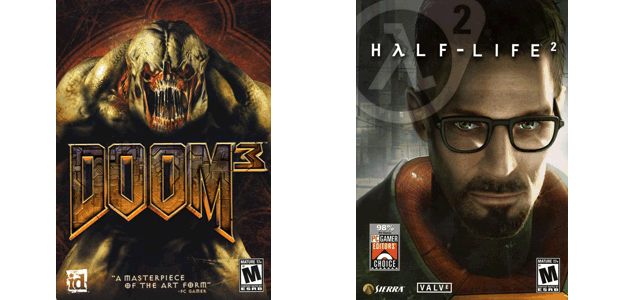
Posted on: October 29, 2014

